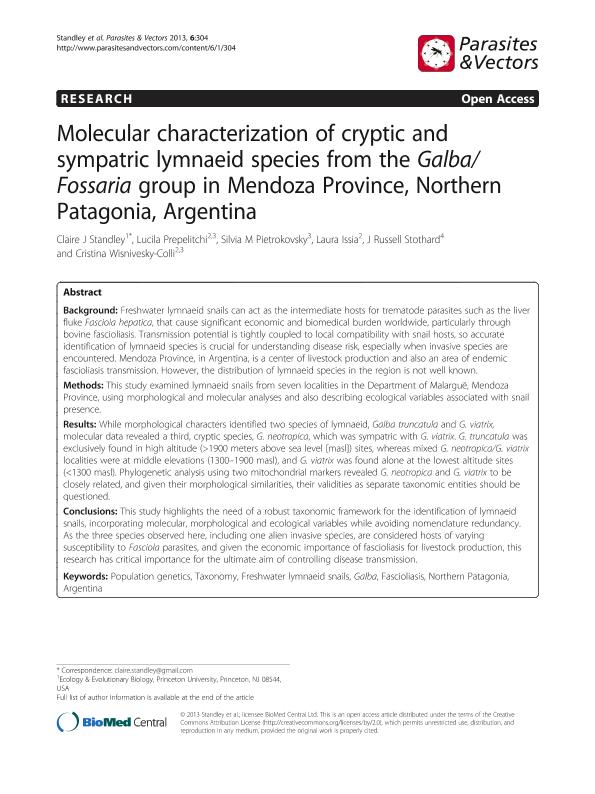Artículo
Molecular characterization of cryptic and sympatric lymnaeid species from the Galba/Fossaria group in Mendoza Province, Northern Patagonia, Argentina
Standley, Claire J.; Prepelitchi, Lucila ; Pietrokovsky, Silvia Monica
; Pietrokovsky, Silvia Monica ; Issia, Laura Andrea; Stothard, J. Russell; Wisnivesky, Maria Cristina
; Issia, Laura Andrea; Stothard, J. Russell; Wisnivesky, Maria Cristina
 ; Pietrokovsky, Silvia Monica
; Pietrokovsky, Silvia Monica ; Issia, Laura Andrea; Stothard, J. Russell; Wisnivesky, Maria Cristina
; Issia, Laura Andrea; Stothard, J. Russell; Wisnivesky, Maria Cristina
Fecha de publicación:
10/2013
Editorial:
BioMed Central
Revista:
Parasites and Vectors
ISSN:
1756-3305
Idioma:
Inglés
Tipo de recurso:
Artículo publicado
Clasificación temática:
Resumen
Background: Freshwater lymnaeid snails can act as the intermediate hosts for trematode parasites such as the liver fluke Fasciola hepatica, that cause significant economic and biomedical burden worldwide, particularly through bovine fascioliasis. Transmission potential is tightly coupled to local compatibility with snail hosts, so accurate identification of lymnaeid species is crucial for understanding disease risk, especially when invasive species are encountered. Mendoza Province, in Argentina, is a center of livestock production and also an area of endemic fascioliasis transmission. However, the distribution of lymnaeid species in the region is not well known. Methods: This study examined lymnaeid snails from seven localities in the Department of Malarguë, Mendoza Province, using morphological and molecular analyses and also describing ecological variables associated with snail presence. Results: While morphological characters identified two species of lymnaeid, Galba truncatula and G. viatrix, molecular data revealed a third, cryptic species, G. neotropica, which was sympatric with G. viatrix. G. truncatula was exclusively found in high altitude (>1900 meters above sea level [masl]) sites, whereas mixed G. neotropica/G. viatrix localities were at middle elevations (1300-1900 masl), and G. viatrix was found alone at the lowest altitude sites (<1300 masl). Phylogenetic analysis using two mitochondrial markers revealed G. neotropica and G. viatrix to be closely related, and given their morphological similarities, their validities as separate taxonomic entities should be questioned. Conclusions: This study highlights the need of a robust taxonomic framework for the identification of lymnaeid snails, incorporating molecular, morphological and ecological variables while avoiding nomenclature redundancy. As the three species observed here, including one alien invasive species, are considered hosts of varying susceptibility to Fasciola parasites, and given the economic importance of fascioliasis for livestock production, this research has critical importance for the ultimate aim of controlling disease transmission.
Archivos asociados
Licencia
Identificadores
Colecciones
Articulos(IEGEBA)
Articulos de INSTITUTO DE ECOLOGIA, GENETICA Y EVOLUCION DE BS. AS
Articulos de INSTITUTO DE ECOLOGIA, GENETICA Y EVOLUCION DE BS. AS
Articulos(SEDE CENTRAL)
Articulos de SEDE CENTRAL
Articulos de SEDE CENTRAL
Citación
Standley, Claire J.; Prepelitchi, Lucila; Pietrokovsky, Silvia Monica; Issia, Laura Andrea; Stothard, J. Russell; et al.; Molecular characterization of cryptic and sympatric lymnaeid species from the Galba/Fossaria group in Mendoza Province, Northern Patagonia, Argentina; BioMed Central; Parasites and Vectors; 6; 304; 10-2013; 1-11
Compartir
Altmétricas



